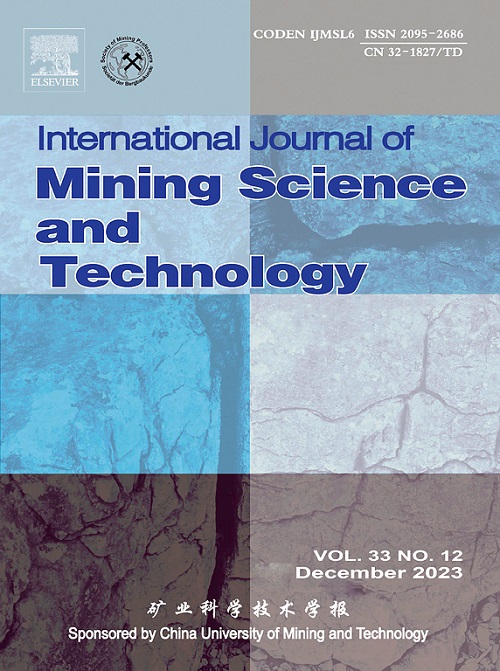Theory and simulation investigations on stability control of gob-side entry retaining with coal pillar-backfill body system
IF 13.7
1区 工程技术
Q1 MINING & MINERAL PROCESSING
International Journal of Mining Science and Technology
Pub Date : 2025-08-01
DOI:10.1016/j.ijmst.2025.07.012
引用次数: 0
Abstract
Gob-side entry retaining (GER) is widely applied in China. Nevertheless, the stability mechanism of the GER with coal pillar-backfill body (CPBB) under dynamic overburden load remains unexplored. A voussoir beam structure (VBS) model is established to analyze roof structure stability during panel advancement, introducing a VBS stability criterion. Reducing block B length l and immediate roof damage variable D, and increasing coal pillar width xc, lowers the GER structure instability risk. Reducing l and the GER width w leads to a CPBB system stability upswing. A UDEC model was established to systematically reveal how the l, backfill body width xb, and strength affect the stability and coupling performance of the CPPB system by monitoring the crack damage DC. Simulation results indicate that at l=14 m, xb=2.0 m, water-cement ratio 1.5:1, the coal pillar and backfill body have similar DC but maintain stability, resulting in CPPB system coupling degree Ϗ better. A novel GER method supported by the CPBB was implemented on-site. Monitoring results indicated that the coal pillar peak stresses were 19.17 MPa (ahead), 16.14 MPa (behind), and the backfill body peak stress was 12.27 MPa (maximum). The floor heave was 380 mm, with a 103 mm backfill body rib.
煤柱-充填体系统空侧留巷稳定性控制理论与仿真研究
采空区侧留巷(GER)在中国得到了广泛的应用。然而,在动覆盖层荷载作用下,带煤柱-充填体(CPBB)采空区的稳定机制仍未明确。为了分析面板推进过程中顶板结构的稳定性,建立了voussoir梁结构(VBS)模型,引入了voussoir梁结构稳定性判据。减小块体B长度l和顶板直接损伤变量D,增大煤柱宽度xc,降低GER结构失稳风险。减小l和GER宽度w导致CPBB系统稳定性上升。建立UDEC模型,通过监测裂缝损伤DC,系统揭示了l、充填体宽度xb和强度对CPPB体系稳定性和耦合性能的影响。仿真结果表明,在l=14 m, xb=2.0 m,水灰比1.5:1时,煤柱与充填体DC相近,且保持稳定,CPPB体系耦合度Ϗ较好。在CPBB的支持下,现场实现了一种新的GER方法。监测结果表明,煤柱峰值应力为19.17 MPa(前)、16.14 MPa(后),充填体峰值应力为12.27 MPa(最大值)。底鼓380 mm,回填体肋103 mm。
本文章由计算机程序翻译,如有差异,请以英文原文为准。
求助全文
约1分钟内获得全文
求助全文
来源期刊

International Journal of Mining Science and Technology
Earth and Planetary Sciences-Geotechnical Engineering and Engineering Geology
CiteScore
19.10
自引率
11.90%
发文量
2541
审稿时长
44 days
期刊介绍:
The International Journal of Mining Science and Technology, founded in 1990 as the Journal of China University of Mining and Technology, is a monthly English-language journal. It publishes original research papers and high-quality reviews that explore the latest advancements in theories, methodologies, and applications within the realm of mining sciences and technologies. The journal serves as an international exchange forum for readers and authors worldwide involved in mining sciences and technologies. All papers undergo a peer-review process and meticulous editing by specialists and authorities, with the entire submission-to-publication process conducted electronically.
 求助内容:
求助内容: 应助结果提醒方式:
应助结果提醒方式:


